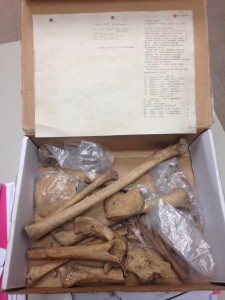The skeletons in Waldorf’s closet

Native American Bones discovered in the bio department. Photo by Alyse DeVries
By Darien Walsh
Waldorf University recently cleaned out its closet, and that meant dealing with the skeletons that live there.
Last semester, a box of Native American remains were discovered in the Waldorf University Biology Department. Freshman biology major Hannah Ashley discovered the bones while digging through the plant lab’s fossil cabinet.
“I found a creepy box from the 1970’s,” said Ashley. “It didn’t have a cover so I figured I’d look. Honestly it was really creepy that they’ve been sitting there for 40 years, and there were only certain pieces.”
The little box, which was given to the University in the 1970’s, had been forgotten over the years. The remains inside were mainly of children dating between 900 and 1200 A.D. The box included a paper catalogue detailing the contents of the box, as well as a description of the dig site. The bones were found in Ohio along the Portage River buried 2 feet deep in the river bank in what is the remains of a burial site. It’s believed the Native Americans died of arthritis, or maybe malaria. There could possibly be 2000 bodies buried in the burial ground. One-third of the burial ground has perhaps already washed into the river.
“It was also really creepy because they were Native American bones so I felt like it was haunted,” said Ashley.
Alyse DeVries, lab manager for the biology department, had the bones in her care until they left the University.
“It never used to be a big deal, to own Native American relics or remains,” said DeVries, “but because of NAGPRA, anything that belongs to tribes goes back to the tribe.”
The Native American Graves Protection and Repatriation Act, or NAGPRA, is a federal law stating that Native American remains and other certain items must be sent back to their tribes unless given permission by the tribe to display in something like a museum.
“At first I thought ‘okay this is really cool,'” said DeVries, “but then I realized that we probably shouldn’t have them.”
DeVries contacted the State Archaeologist about the remains, and on March 18 the director of the University of Iowa Biological Archaeological Department visited campus and took them back to Iowa City for further testing. There, they will try to figure out what tribe the bones are from, and then send them to the tribe for a ceremonial reburial. If the tribe identity of the bones is undiscovered, they will be buried in one of the four different tribal cemeteries in Iowa.
Returning the remains and having NAGPRA in place is important for a number of reasons. The law offers greater protection of grave sites, stopping looters and thieves, making it officially illegal to own Native American bones.
“The law respects their history and regulates the protection of their culture,” said DeVries.
“It’s important to ceremonially rebury them because of history and the way the culture was treate.” said DeVries. “The culture is very spiritually connected to their ancestors, and it’s important to fulfill their aspects of spirituality and honor their traditions.”
